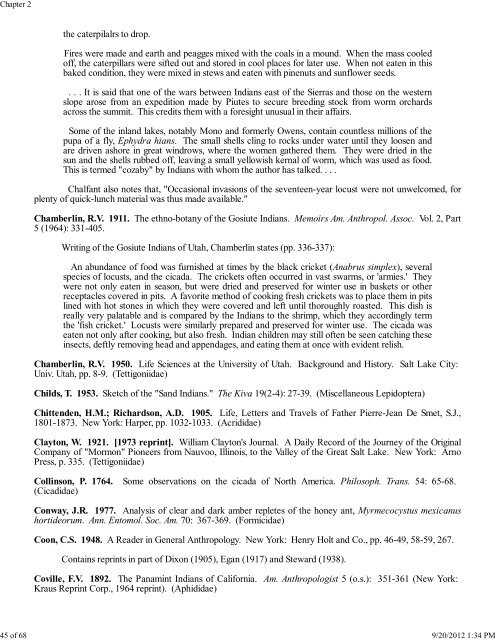Chapter 2. Insect Foods of North American Indigenous Populations ...
Chapter 2. Insect Foods of North American Indigenous Populations ...
Chapter 2. Insect Foods of North American Indigenous Populations ...
You also want an ePaper? Increase the reach of your titles
YUMPU automatically turns print PDFs into web optimized ePapers that Google loves.
<strong>Chapter</strong> 245 <strong>of</strong> 68 9/20/2012 1:34 PMthe caterpilalrs to drop.Fires were made and earth and peagges mixed with the coals in a mound. When the mass cooled<strong>of</strong>f, the caterpillars were sifted out and stored in cool places for later use. When not eaten in thisbaked condition, they were mixed in stews and eaten with pinenuts and sunflower seeds.. . . It is said that one <strong>of</strong> the wars between Indians east <strong>of</strong> the Sierras and those on the westernslope arose from an expedition made by Piutes to secure breeding stock from worm orchardsacross the summit. This credits them with a foresight unusual in their affairs.Some <strong>of</strong> the inland lakes, notably Mono and formerly Owens, contain countless millions <strong>of</strong> thepupa <strong>of</strong> a fly, Ephydra hians. The small shells cling to rocks under water until they loosen andare driven ashore in great windrows, where the women gathered them. They were dried in thesun and the shells rubbed <strong>of</strong>f, leaving a small yellowish kernal <strong>of</strong> worm, which was used as food.This is termed "cozaby" by Indians with whom the author has talked. . . .Chalfant also notes that, "Occasional invasions <strong>of</strong> the seventeen-year locust were not unwelcomed, forplenty <strong>of</strong> quick-lunch material was thus made available."Chamberlin, R.V. 1911. The ethno-botany <strong>of</strong> the Gosiute Indians. Memoirs Am. Anthropol. Assoc. Vol. 2, Part5 (1964): 331-405.Writing <strong>of</strong> the Gosiute Indians <strong>of</strong> Utah, Chamberlin states (pp. 336-337):An abundance <strong>of</strong> food was furnished at times by the black cricket (Anabrus simplex), severalspecies <strong>of</strong> locusts, and the cicada. The crickets <strong>of</strong>ten occurred in vast swarms, or 'armies.' Theywere not only eaten in season, but were dried and preserved for winter use in baskets or otherreceptacles covered in pits. A favorite method <strong>of</strong> cooking fresh crickets was to place them in pitslined with hot stones in which they were covered and left until thoroughly roasted. This dish isreally very palatable and is compared by the Indians to the shrimp, which they accordingly termthe 'fish cricket.' Locusts were similarly prepared and preserved for winter use. The cicada waseaten not only after cooking, but also fresh. Indian children may still <strong>of</strong>ten be seen catching theseinsects, deftly removing head and appendages, and eating them at once with evident relish.Chamberlin, R.V. 1950. Life Sciences at the University <strong>of</strong> Utah. Background and History. Salt Lake City:Univ. Utah, pp. 8-9. (Tettigoniidae)Childs, T. 1953. Sketch <strong>of</strong> the "Sand Indians." The Kiva 19(2-4): 27-39. (Miscellaneous Lepidoptera)Chittenden, H.M.; Richardson, A.D. 1905. Life, Letters and Travels <strong>of</strong> Father Pierre-Jean De Smet, S.J.,1801-1873. New York: Harper, pp. 1032-1033. (Acrididae)Clayton, W. 1921. [1973 reprint]. William Clayton's Journal. A Daily Record <strong>of</strong> the Journey <strong>of</strong> the OriginalCompany <strong>of</strong> "Mormon" Pioneers from Nauvoo, Illinois, to the Valley <strong>of</strong> the Great Salt Lake. New York: ArnoPress, p. 335. (Tettigoniidae)Collinson, P. 1764. Some observations on the cicada <strong>of</strong> <strong>North</strong> America. Philosoph. Trans. 54: 65-68.(Cicadidae)Conway, J.R. 1977. Analysis <strong>of</strong> clear and dark amber repletes <strong>of</strong> the honey ant, Myrmecocystus mexicanushortideorum. Ann. Entomol. Soc. Am. 70: 367-369. (Formicidae)Coon, C.S. 1948. A Reader in General Anthropology. New York: Henry Holt and Co., pp. 46-49, 58-59, 267.Contains reprints in part <strong>of</strong> Dixon (1905), Egan (1917) and Steward (1938).Coville, F.V. 189<strong>2.</strong> The Panamint Indians <strong>of</strong> California. Am. Anthropologist 5 (o.s.): 351-361 (New York:Kraus Reprint Corp., 1964 reprint). (Aphididae)
















